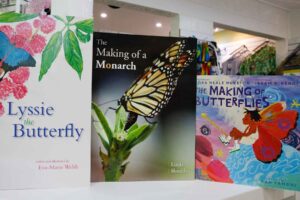It’s a dangerous world out there for butterflies and their battle for life.
From the time an egg is laid it is in danger, eggs are a succulent morsel for small predators like mites, ants and spiders. Microscopic wasps will lay their egg inside a butterfly egg, then the wasp larvae will hatch out inside and eat the forming butterfly caterpillar. There are also many viruses, disease and fungi, especially in the tropics.
Caterpillars can at least move and hide but they aren’t very fast on their feet and as they eat and grow they become more conspicuous. An eaten leaf is a big sign to sharp eyed birds that there may be a tasty caterpillar nearby. Lots of caterpillars are green and camouflage really well with the host plant and others look unappetising. Some caterpillars are poisonous to predators. These caterpillars get their toxicity from the plants they eat. Generally, the brightly coloured larvae are poisonous.
Pupae are stuck in one place but tend to be very well camouflaged. They are targets for parasitic flies, wasps and spiders.
Butterflies have the best defence because they can fly! So the main flying predators are birds, followed by hornets, wasps, dragonflies and praying mantis. Even non-flying predators can still catch them though – spiders spin webs that the butterflies get stuck in. Lots of spiders are ambush experts and lurk around flowers to snatch the unsuspecting butterfly. Lizards, frogs, small mammals, ants are also predators – and I’m sure I’ve missed a few!
As strange as it sounds, the best outcome from all these predators is population control. If all the butterfly eggs that were laid in one generation made it through the life cycle to become a butterfly, there would be no leaves left for the next generation of caterpillars, ultimately leading to their own demise. Predators can be a good thing!
Thanks to Tanya for this week’s Friday Fun Fact!






